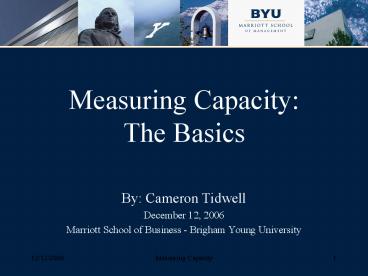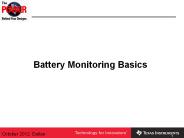Measuring Capacity: The Basics - PowerPoint PPT Presentation
1 / 39
Title:
Measuring Capacity: The Basics
Description:
Measuring Capacity: The Basics By: Cameron Tidwell December 12, 2006 Marriott School of Business - Brigham Young University So What is Capacity? What do YOU think ... – PowerPoint PPT presentation
Number of Views:560
Avg rating:3.0/5.0
Title: Measuring Capacity: The Basics
1
Measuring CapacityThe Basics
- By Cameron Tidwell
- December 12, 2006
- Marriott School of Business - Brigham Young
University
2
SoWhat is Capacity?
- What do YOU think Capacity is?
- Google the term Measuring Capacity what comes
up?
3
Google search results
- Possible finds
- Math activities
- Units of measurements
- Cups, Gallons, Ounces etc.
- Ideas for teachers
- Measuring Capacity fisheries and Web Servers
4
What is going to be covered
- What is Capacity?
- Difference Between Measuring and Calculating
- Efficiency
- Utilization
- Real World Examples
- Applications
5
Capacity Defined
- Capacity is the capability of a worker, machine,
plant, organization to provide goods and services
(output) per period of time.
6
An easy way to remember
- Capacity is like a Funnel.
- Wrights Funnel was developed by Oliver Wright
demonstrate the idea of capacity. - (Blackstone, 1989)
7
However
- The Funnel only focuses on OUTPUTS. Capacity can
also be measured by an organizations INPUTS. - (Blackstone, 1989)
8
Units of Measurements
- INPUTS
- Number of Labor Hours available in a time period
- Number of Machines Hours available in a time
period - Seats on an airplane
- Beds in a Hospital
- OUTPUTS
- Number of units produced in a time period
- Cars washed per hour
- Beds assembled per day
- Oil changes per hour
9
What are Possible units of measure of Capacity
for the following?
- A Bottling Company?
- Work Hours, Bottles Filled
- An Car Dealership?
- Cars sold, Cars serviced
- What about your Organization?
- ?
10
Lets Think
- What is the benefit of knowing capacity?
- How could it help an organization?
- How could knowing how to measure capacity benefit
this organization?
11
Measuring/Calculating Capacity
- John H. Blackstones Capacity Management,
distinguishes between the two - Measuring Capacity
- One averages some set of historical data.
- Calculating Capacity
- One sets capacity equal to the product of time
available (T), efficiency (E), and utilization
(U). - C T x E x U
- (Blackstone, 1989)
12
Measuring Capacity
- This part is easy
- 1. Take historical outputs from equal time
periods and add them together. - (output 1 output 2 output N)
- 2. Divide the total output by the number of
periods. - (output 1 output 2 output N)/ periods
13
Measuring Capacity
- Example
- Louisville Sluggers factory in Louisville, KY
produced an output of 2700 bats, 2000 bats, 1900
bats, and 2400 bats. What is the measured
capacity?
14
Louisville Slugger
- Step one Add the Historical Data
- 2700200019002400 9000 bats
- Step two Divide the total by the number of
periods, 4. - 9000/4 2250 bats
- Thus, 2250 bats is the average capacity.
15
Calculating Capacity
- Now it gets a little tricky
- Capacity ( of shifts) x ( of hours a day) x
( of machines) x ( of days a week) - (Provides Mins and Maxs in the ability to
produce) - Important! Variables are subject to change
depending on information
16
Calculating Capacity
- Example
- Ford has a factory in Detroit which produces
transmissions. The factory has 2 shifts which man
4 machines, 8 hours day, 6 days a week. What is
the factorys calculated capacity?
17
Ford cont.
- Remember the Equation
- Capacity ( of shifts) x ( of hours a day) x
( of machines) x ( of days a week) - There were 2 shifts, 4 machines, 8 hours a day,
and 6 days wk - Capacity (2) x (4) x (8) x (6)
- Capacity 384 standard hours per week
18
Even more Ford.
- As mentioned Capacity T x E x U.
- This calculated capacity is also call Rated or
Nominal Capacity. - Example cont.
- Say that Ford historically has a utilization of
93 and a efficiency of 98 then what would
their capacity equal?
19
Even more Ford cont.
- Capacity T x E x U
- Time Available 384 hrs Efficiency .98
Utilization .93 - Capacity (384) x (.98) x (.93)
- Capacity 349.98
- Capacity 350 standard hours
20
Efficiency
- Definition
- A measure (usually expressed as a percentage)
of the actual output to the standard output
expected. - (APICS Dictionary, 1998)
21
Calculating Efficiency
- Efficiency Standard hours x 100
- Hours worked
- -or-
- Efficiency Actual units produced x 100
- Standard rate of production expected
22
Calculating Efficiency
- Example
- At company X work is measured in hours. It took
employees 12.75 hours to produce 12 standard
hours of work. What is the companies efficiency?
23
Calculating Efficiency
- Efficiency Standard hours x 100
- Hours worked
- (Standard Hours 12 Hours worked 12.75)
- Efficiency 12 .9412 x 100
- 12.75
- Efficiency 94.12
24
Lets try a different one
- Example
- Company Y produces a standard of 250 units per
hours. Today, in one eight hour shift the company
produced 1925 units. What was the companys
efficiency for the shift today?
25
Calculating Efficiency
- Efficiency Actual units produced x 100
- Standard rate of production expected
- Actual units produced 1925 units
- Standard rate of production expected ?
- (250 units per hour x 8 hours per shift 2000)
26
Calculating Efficiency
- Efficiency Actual units produced x 100
- Standard rate of production expected
- Efficiency 1925 .9625 x 100
- 2000
- Efficiency 96.25
27
Utilization
- Definition
- A measure (usually expressed as a percentage) of
how intensively a resources is being used to
produce a good or service. - (APICS Dictionary, 1998)
28
Calculating Utilization
- Utilization Hours available hours down x 100
- Hours available
- Utilization Hours worked x 100
- Hours available
29
Calculating Utilization
- Example
- Your company has 4 machines which are staffed by
2 eight hours shifts 6 days a week. Lately
information has shown that there are about 20 per
week in which machines are not in use due to
breakdowns. Calculate your companies machine
utilization.
30
Calculating Utilization
- Capacity ( of shifts) x ( of hours a day) x
( of machines) x ( of days a week) - Utilization Hours available hours down x 100
- Hours available
- Utilization Hours worked x 100
- Hours available
31
Calculating Utilization
- First step, the companys machine hour capacity?
- Capacity ( of shifts) x ( of hours a day) x
( of machines) x ( of days a week) - Capacity (2 shifts) x (8 hours a day) x (4
machines) x (6 days a week) - Capacity 384 machine hours
32
Calculating Utilization
- Second Step
- Utilization Hours available hours down x 100
- Hours available
- Utilization (384 machine hours) (20 hours
down) x 100 - 384 machine hours
- Utilization 364 machine hours x 100 .9479 x
100 - 384 machine
hours - Utilization 94.79
33
Real World Example
- Fisheries in Europe
- A measure that has gained increase use in
fisheriesis capacity utilization - (Pascoe, 2004)
- Capacity and Utilization are being determine
based on the same ideas but much more in depth.
34
One final point on Utilization
- Note that
- Over Utilization
- Machine Breakdown
- Decrease in quality
- Lost time injuries
- Under Utilization
- Increase Costs
- Employees downtime (standing around)
35
Applications cont.
- What is the right utilization and efficiency
level for your organization? - Companies need to find their Best Operating
Level
36
Review
- What is Capacity?
- What is the Difference between Measuring and
Calculating Capacity? - How does one determine Efficiency?
- How does one determine Utilization?
37
Readings List
- Blackstone, J.H. (1989). Capacity Management.
Ohio South-Western Publishing. - Bozarth, C.C. Handfield R.B. (2005).
Introduction to Operations and Supply Chain
Management. New Jersey Pearson Education - Cox, J.F. Blackstone, J.H. eds. (1998). APICS
Dictionary (9th ed.) Virginia APICS
38
Readings List
- Fare, R., Grosskopf, S., Kokkelenberg, E. C.
(1989). Measuring Plant Capacity, Utilization
and Technical Change A Nonparametric Approach.
International Economic Review, 30 (3), 655-666. - Newman, M. (2006). Empty wards and
promises. Hospital Doctor, 20-22. - Mahanti, T. K. (2006, October 2). Higher capacity
utilisation raises global competitiveness. Knight
Ridder Trinbune Business News. pg 1.
39
Readings List
- Morlok, E. K., Chang, D. J. (2004). Measuring
capacity flexibility of a transportation system.
Transportation Research Part A Policy
Practice, 38 (6), 405-420. - Pascoe, S., Greboval, D., Kirkley, J., Lindebo,
E. (2004) Measuring and appraising capacity in
fisheries framework, analytical tools and data
aggregation. Rome FAO Fisheries Circular. No.
994 - Ruist, E., Söderström, H. T. (1975). Measuring
Capacity Utilization and Excess Demand. European
Economic Review, 6 (4), 369-386. - Taverna, M. A. (1998). BMW Rolls-Royce Targets
Development Capacity Issues. Aviation Week
Space Technology, 149 (16), 77.































